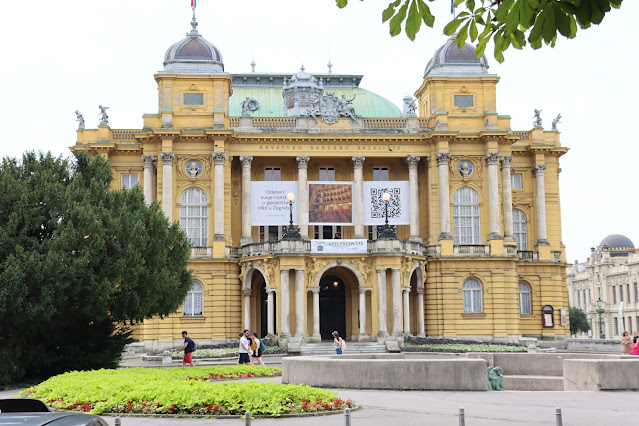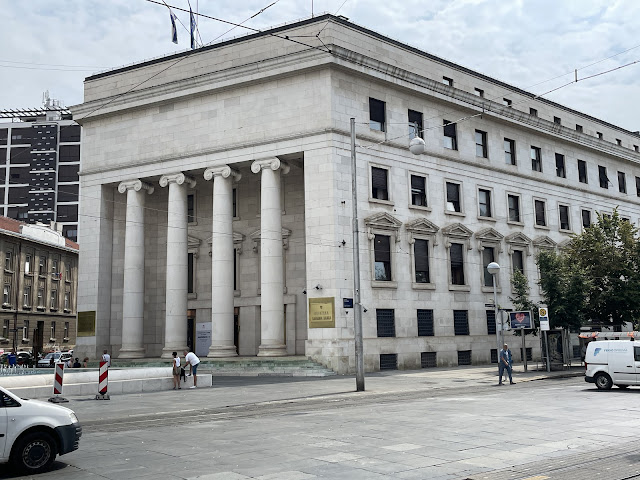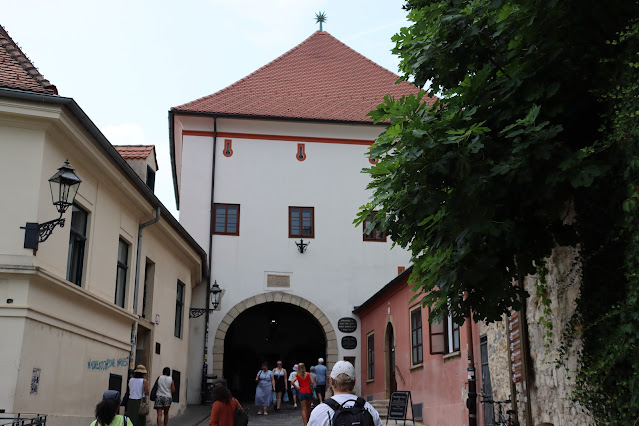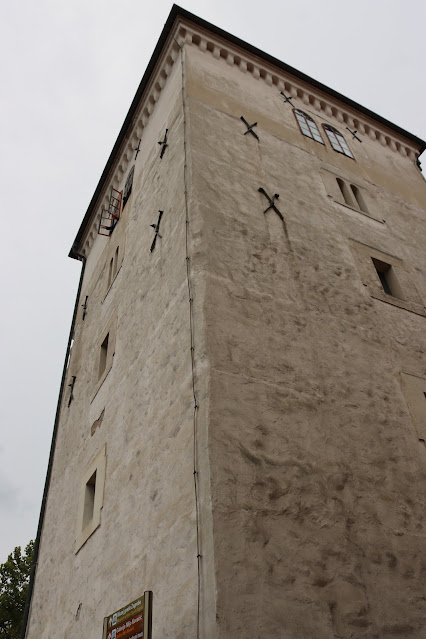Today we toured Zagreb, the capital of Croatia.
The area that is now the Republic of Croatia, was populated by the Croat people from 6th century, and the independent dutchy of Croatia was created in 879. It became a kingdom in 925 and formed a union with Hungary in 1102 when the Trpimirović royal dynasty ended. To protect themselves from the Ottomans, the Croatians elected an Austrian ruler in 1527. Croatia then became part of the State of Slovenes, Croats and Serbs after World War I and then part of Yugoslavia. In World War II the country became a puppet state of the Nazis, returning to Yugoslavia after the war. In 1991 Croatia broke free of Yugoslavia and fought a four and a half year long war of independence against the Yugoslavian People's Army and the Socialist Federal Republic of Yugoslavia.
Zagreb is the capital of Croatia, and lies on the Sava river on the Medvednica Mountain. The area was first settled by Romans as Andautonia in 1st century AD, and became Zagreb in 1134. The name possibly comes from the Proto-Slavic word for hill (grębъ) or the Old Slavic word for riverbank (breg).
We drove into town and found a park, before starting our walk towards our first destination.
Along our initial walk we passed several monuments and churches:
 |
| Church of Transfiguration of the Lord (Hram preobraženja Gospodnjeg), built 1865 |
 |
| Monument to Petar Preradović, Croatian Poet (1818-1872) |
 |
| Monument to Nikola Tesla |
 |
| Bakers in a shop window |
 |
| Street Art |
 |
| Croatian National Dress |
 |
| The super-helpful and not information overload sign posts |
 |
| Euro Football results up on the wall outside a pub |
 |
| Museum of Unfinished Art |
Our first major destination was the Croatian National Theatre. This impressive building in the Republic of Croatia Square was built in 1895:
We then continued onward passing some more statues and a Meteorological station in Park Zrinjevac. A random side note here - Google maps listed the Meteorological station as "More Busy that Normal", there were two people looking at it when we arrived...
 |
| St George and the Dragon |
From here we headed into the main part of Zagreb Old Town - Kapitol Square, passing a few more impressive buildings, such as the Croatian National Bank:
In Kapitol Square we stopped to check out a few of the sights.
The first was the Holy Mary Monument:
Kapital Square was home to Kapitol Fortress - the walls surrounding the Zagreb Cathedral.
 |
| My highlight was this nun arguing with a delivery guy |
Unfortunately the very impressive Zagreb Cathedral was undergoing repairs after the 2020 Zagreb Earthquake, which caused the tip of the southern spire to fall through the roof of the Archbishop's Palace and the northern spire to lean. 30m of each of these spires were removed and were being reconstructed by replacing each block (between 100 - 1200kg each) with a 3d printed travertine (limestone) block.
The Cathedral, also known as Cathedral of the Assumption of the Blessed Virgin Mary and Saints Stephen and Ladislav, was built in the mid 1200s, and is the second tallest building in Zagreb (when it has both towers). The towers originally made the cathedral 108.4m high, one of the tallest churches in the world. The 2020 Earthquake wasn't the first to damage the cathedral, it was also severely damaged in 1880 (6.3 on the Richter Scale).
The square was also host to a large metal map of Zagreb:
We then continued onward to our next destination, past another few landmarks:
The Church of St. Frances of Assisi:
Tolkein's House - a Lord of the Rings themed Pub:
And down the Bishop Duh Steps:

Our destination was the Stone Gate, but at this point our trip nearly became unraveled. Each place we stop at, we try to purchase a cloth badge with the town, country or district name and logo. These are slightly harder to find that magnets or other souvenirs, so it adds a bit of searching. One of the smaller souvenir shops we ducked into had a fairly acrid smell in the air and Tomas immediately ducked back outside. I was about to leave when Kristine barreled past me and out the door. Whatever had created the smell was a nut-based diffuser and it triggered Kristine's allergies. We walked slightly down the street and Kristine already was getting an itchy throat and a cough. She popped an anti-histamine and sat down to catch her breath while the reaction passed. As it was really hot, we were all sweaty and Kristine was pretty red, so we had a helpful family stop to offer us water, thinking that Kris had collapsed due to the heat. After about 10 minutes or so the anti-histamines kicked and Kristine was able to continue.
Our next stop was the Stone Gate (Kamenita vrata), built in the mid 1200s and redesigned in the 1700s. The gate houses a shrine to "God's Mother of the Stony Gate" and is considered a holy place:
 |
| Statue leading up to the Gate |
 |
| The shrine |
The next stop was the Church of Saint Mark (Crkva sv. Marka), one of the oldest buildings in Zagreb. The church was built in the 1200s and reconstructed in the late 1300s (changing from Romanesque to Gothic). the roof tiles display the coat of arms of Zagreb and of the Triune Kingdom of Croatia, Slavonia and Dalmatia:
 |
Original Gothic sculptures - Joseph and Mary with baby Jesus at top, St Mark and the Lion and Twelve Apostles
|
Our next stop was the Lotrščak Tower, which fires a cannon every day at noon. It was just past 11:40, so we moved quickly, stopping only to take a few more photos of other buildings before arriving at the tower just as the countdown started.
The first building we passed was the Greek Catholic Co-Cathedral of St. Cyril and Methodius (Grkokatolička konkatedrala Sv. Ćirila i Metoda), a neo-Byzantine church which was built in 1886 to replace a Greek Catholic church and seminary that existed since 1681.
We then passed the City Assembly of the City of Zagreb with its engravings over the doors:
The Church of St Catherine (Crkva sv. Katarine) a baroque church built in 1632 and rebuilt after fires in 1645 and 1674 and repaired after the 1880 earthquake:
Lotrščak Tower was part of the old city fortifications, built in the 1200s to guard the southern gate of the Upper Town. The name comes from the Latin for "Thieves Bell" (Campana Latrunculorum) which was named for the bell used to signal the closing of the town gates.
In 1877 a cannon was placed in the top of the tower (the Grič cannon) and is fired every day to mark midday and signal the ringing of the noon church bells. We arrived at the tower just in time to witness the cannon firing, which was pretty loud as you can tell by the jump in the video when it fires:
Our final stop was an attempt to find the Grič Tunnel. As you can probably tell by the pictures above, there were a lot of renovations and repairs going on in Zagreb, and as such there were a lot of fences and construction works. We couldn't find a clean path to where the GPS said the tunnel was, so we had to squeeze past some fencing into Grič Park outside a derelict building:
Eventually, Kristine and Cameron stopped for a rest and loaded Pokémon Go, and the tunnel came up as a landmark. It turns out the entrance was below the park, so we headed down some stairs and found it.
The Grič Tunnel was built in World War II as a pedestrian tunnel under the Grič neighborhood. It was designed to serve as a path and also as a bomb shelter. After the war it was abandoned, but it was renovated and repaired in 1990 to host one of Croatia's first rave parties and to host tourist and cultural events. The tunnel itself is 350m long and 3.2m wide with four additional exits along the route.
We then headed back to the car, passing the statue of Count Josip Jelačić von Bužim on the way. Count Josep (1801-1859) was a field marshal in the Imperial Austrian army and Croatian politician.
Our trip through Zagreb had been pretty interesting, with some amazing buildings. It was unfortunate that a lot was closed for repairs or renovations, but understandable considering the 2020 earthquake.
Here's a snap shot of a few of the other building facades from the trip:
We left Zagreb in the early afternoon for our two hour drive to Rijeka. The weather turned pretty wet along the drive, but we did get to see some nice castles in the distance:
The trip up to Rijeka was quite windy and mountainous, but our accomodation was comfortable and, since we had two days, we managed to get some washing done and get a bit more settled.














































































No comments:
Post a Comment